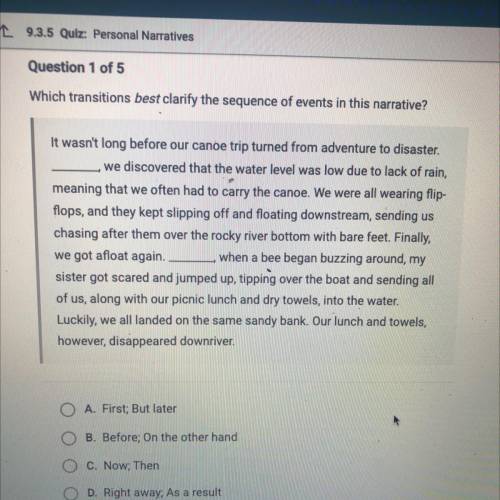
Which transitions best clarify the sequence of events in this narrative?
It wasn't long before our canoe trip turned from adventure to disaster.
we discovered that the water level was low due to lack of rain,
meaning that we often had to carry the canoe. We were all wearing flip-
flops, and they kept slipping off and floating downstream, sending us
chasing after them over the rocky river bottom with bare feet. Finally,
we got afloat again. when a bee began buzzing around, my
sister got scared and jumped up, tipping over the boat and sending all
of us, along with our picnic lunch and dry towels, into the water.
Luckily, we all landed on the same sandy bank. Our lunch and towels,
however, disappeared downriver.
A. First; But later
B. Before; On the other hand
C. Now; Then
D. Right away; As a result


Answers: 2


Another question on English


English, 22.06.2019 03:50
What is dialogue? a. conversations that takes place between characters b. directions left by the playwright on a script c. instructions that indicate actors' stage positions d. the props that represent a play's physical location
Answers: 1

English, 22.06.2019 04:50
How does the poem "the lady of shalott" by alfred, lord tennyson convey the position of victorian women? a curse is on her if she stay to look down to camelot. she knows not what the curse may be, and so she weaveth steadily, and little other care hath she, the lady of shalott. and moving thro' a mirror clear that hangs before her all the year, shadows of the world appear. there she sees the highway near winding down to camelot: there the river eddy whirls, and there the surly village churls, and the red cloaks of market girls, pass onward from shalott. a. most victorian women were restricted to their homes. b. victorian women were confined to domestic duties. c. most victorian women worked hard but were often bored. d. victorian women employed themselves by weaving.
Answers: 1

English, 22.06.2019 05:30
Compare how this myth is portrayed in the painting and in the text. is the mood similar or different? how do the painter and the author create these moods
Answers: 1
You know the right answer?
Which transitions best clarify the sequence of events in this narrative?
It wasn't long before our...
Questions



Mathematics, 06.06.2020 21:59


Computers and Technology, 06.06.2020 21:59







Mathematics, 06.06.2020 21:59


Mathematics, 06.06.2020 21:59




Mathematics, 06.06.2020 21:59

Mathematics, 06.06.2020 21:59



